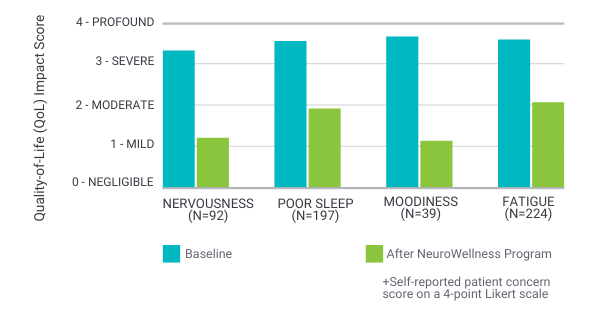What is Burnout?
According to the World Health Organization (WHO), burnout is “a syndrome conceptualized as resulting from chronic workplace stress that has not been successfully managed.” The WHO further describes burnout via these three aspects:1
- The feeling of energy depletion or exhaustion
- Increased mental distance from one’s job or feelings of negativism or cynicism related to one’s job
- Reduced professional efficacy
Stress Response Basics
Normally, cortisol is secreted in a circadian rhythm controlled by the hypothalamus which receives input from the environment. The cortisol levels are determined by the overall health of the adrenal glands.2
When we encounter a stressor, the hypothalamic-pituitary-adrenal (HPA) axis is stimulated:
- The adrenal medulla secretes the neurotransmitters norepinephrine and epinephrine, key players in the fight-or-flight response.
- The adrenal cortex increases cortisol production.
- Eventually, the HPA axis feedback loop creates signals to return cortisol levels back into the normal range under ordinary circumstances.
Burnout: HPA Axis Dysfunction
Burnout can contribute to HPA axis dysregulation.
Abnormal stress disrupts the circadian rhythm of cortisol and can have physiological and psychological effects that continue past the elimination of the stressor.2
Stress, such as unmanaged workplace stress in burnout, can eventually diminish cortisol production. Despite repeated stimulation by the stressor, the body may no longer adequately respond and adapt to stress.
Along with the exhaustion, negativism, and decreased efficacy in burnout, stress can have other effects including:
- Cognitive impairment including poor memory and attention2-4
- Increased risk for cardiovascular disease2
- Impaired immunity2
- Disruptions in intestinal microflora2
Patients and Practitioners—No One is Exempt
Burnout is a global phenomenon that can affect many types of workers. Particularly affected may be healthcare practitioners. One study found that over half of physicians in the US are experiencing burnout.5
This can become an overwhelming problem. Intervention with an ongoing therapeutic strategy is often necessary – not only for practitioners helping clients with burnout but for the practitioners who may be struggling with burnout as well.
Holiday for Health
Good news—the effects of burnout and stress may be reversible. Some research shows that after one month of reduced stress, previously high-stress individuals showed no significant difference in perceived stress or attention shifting from a low-stress control group.3
In addition to taking a holiday for health, there are a variety of tested interventions that may aid those experiencing burnout6, such as:
- Counseling and cognitive-behavioral therapy
- Art therapy
- Stress management
- Mindfulness-based meditation
Test, Assess, Restore
Utilizing Sanesco’s NeuroWellness Program can also help practitioners identify and address imbalances that may occur in overly-stressed or burned-out patients.
- Neuroendocrine Lab Testing: Test neurotransmitter and adrenal hormone levels with the HPA profile.
- Personalized neuroendocrine analysis reporting: Assess the patient’s HPA axis function using the personalized neuroendocrine analysis report, a comprehensive view of evidence-based correlations between lab values and self-reported quality-of-life issues.
- Targeted Nutritional Therapy™ (TNT): Implement TNT formulas to support HPA axis balance and improve patient outcomes.*
Retest neurotransmitter and adrenal hormone levels to measure improvement and adjust TNT protocol as needed.
Proven to Reduce Burnout Symptoms
A statistical analysis of 703 patients who followed these steps found:7
- 42.5% reduction in the severity of fatigue (p<0.05)
- 40.8% reduction in poor focus (p<0.05)
- 42.1% reduction in poor memory (p<0.05)
Are You Burned Out?
Assess burnout with the HPA profile, which offers a comprehensive analysis of neurotransmitters and adrenal hormones. Log in or create an account to order the HPA profile today.
If you are a patient, find a Sanesco provider in your area.
References
- World Health Organization. (2019, May 28). Burn-out an “occupational phenomenon”: International Classification of Diseases. Retrieved from https://www.who.int/mental_health/evidence/burn-out/en/
- Head K & Kelly G. Alternative Medicine Review. 2009;14(2):114-140.
- Liston C, et al. Proceedings of the National Academy of Sciences. 2009;106(3):912-917.
- Deligkaris P, et al. Work & stress, 2014;28(2):107-123.
- Shanafelt TD, et al. Changes in burnout and satisfaction with work-life balance in physicians and the general US working population between 2011 and 2014. In Mayo Clinic Proceedings 2015, December (Vol. 90, No. 12, pp. 1600-1613). Elsevier.
- Wiederhold BK, et al. Open Medicine, 2018;13(1):253-263.
- Watkins RW, et al. Guide Your Patients Towards Optimal Neuroendocrine Health Using an Evidence-Based Clinical Approach. Sanesco Research Monograph #2. 2018.
*These statements have not been evaluated by the Food and Drug Administration. This product is not intended to diagnose, treat, cure, or prevent any disease.
Clinical Contributor
Emily Harrill
Clinical Support Specialist at Sanesco International, Inc.
Emily Harrill is our newest Clinical Support Specialist and a graduate of UNC Asheville with a Bachelor of Science in Health and Wellness Promotion. Improving the quality of life for others is her ultimate goal. She enjoys being a part of the team at Sanesco, exploring wellness through the HPA-T Axis and encouraging others to use holistic, integrative means to achieve balanced health. She loves participating in challenging, empowering, and fun activities – especially Olympic weightlifting and belly dance.



